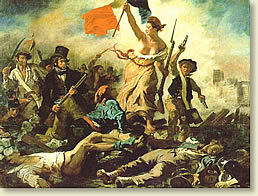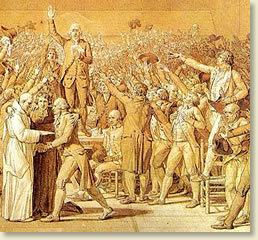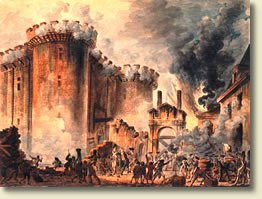|
The Beginning of the
French Revolution, 1789
King Louis XVI needed money. His financial
crisis forced the French monarch to reluctantly convene the Estates General in
order to levy a new land tax that would hopefully solve his monetary woes. It
had been 175 years since the last meeting of this deliberative body that included
representatives of three Estates: the First comprised of the clergy, the Second
comprised of the nobility and the Third comprised of the middle and lower classes.
 |
An allegorical depiction
of the Revolution |
The Estates began their meeting at Versailles on May 5, 1789 and quickly entered
into a power struggle. The Third Estate soon declared itself a "National Assembly" that
was representative of the people. This new National Assembly expressed its desire
to include the other two Estates in its deliberations but also made it clear
that it was determined to move forward without them. Louis attempted to shut
down the National Assembly, but on June 20 its members declared that they would
not disband until they had written a new constitution for France.
The tension increased, exacerbated by massive crop failures that led to a shortage
of food. In Paris, mobs filled the city's streets. The fear spread that the
king would retaliate with force. On July 14 the mob stormed the Bastille to
obtain arms. The attack launched the nation down a pathway that would eventually
lead to the destruction of the monarchy and the
execution of Louis XVI.
Thomas Jefferson was America's minister to France in
1789. As tensions grew and violence erupted, Jefferson traveled to Versailles
and Paris to observe events first-hand. He reported his experience in a series
of letters to America's Secretary of State, John Jay.
We join Jefferson's
story as tensions escalate to violence on July 12:
"July 12
In the afternoon a body of about 100 German cavalry were advanced and drawn up in the Place Louis XV. and about 300 Swiss posted at a little distance in their rear. This drew people to that spot, who naturally formed themselves in front of the troops, at first merely to look at them. But as their numbers increased their indignation arose: they retired a few steps, posted themselves on and behind large piles of loose stone collected in that Place for a bridge adjacent to it, and attacked the horse with stones. The horse charged, but the advantageous position of the people, and the showers of stones obliged them to retire, and even to quit the field altogether, leaving one of their number on the ground. The Swiss in their rear were observed never to stir. This was the signal for universal insurrection, and this body of cavalry, to avoid being massacred, retired towards Versailles.
The people now armed themselves with such weapons as they could find in Armourer's shops and private houses, and with bludgeons, and were roaming all night through all parts of the city without any decided and practicable object.
July 13
The next day the States press on the king to send away the troops, to permit the Bourgeoisie of Paris to arm for the preservation of order in the city, and offer to send a deputation from their body to tranquillize them. He refuses all their propositions. A Committee of magistrates and electors of the city are appointed, by their bodies, to take upon them it's government.
The mob, now openly joined by the French guards, force the prisons of St. Lazare, release all the prisoners, and take a great store of corn, which they carry to the corn market. Here they get some arms, and the French guards begin to form and train them. The City committee determines to raise 48,000 Bourgeois, or rather to restrain their numbers to 48,000.
July 14
 |
The "Tennis Court Oath."
Forced to meet on a tennis court,
the National Assembly vows to
continue
meeting until they write
a new constitution. June 20, 1789 |
On the 14th, they send one of their members (Monsieur de Corny, whom we knew in America) to the Hotel des Invalides to ask arms for their Garde Bourgeoise. He was followed by, or he found there, a great mob. The Governor of the Invalids came out and represented the impossibility of his delivering arms without the orders of those from whom he received them.
De Corney advised the people then to retire, retired himself, and the people took possession of the arms. It was remarkable that not only the Invalids themselves made no opposition, but that a body of 5000 foreign troops, encamped within 400 yards, never stirred.
Monsieur de Corny and five others were then sent to ask arms of Monsieur de Launai, Governor of the Bastille. They found a great collection of people already before the place, and they immediately planted a flag of truce, which was answered by a like flag hoisted on the parapet. The deputation prevailed on the people to fall back a little, advanced themselves to make their demand of the Governor, and in that instant a discharge from the Bastille killed 4. people of those nearest to the deputies. The deputies retired, the people rushed against the place, and almost in an instant were in possession of a fortification, defended by 100 men, of infinite strength, which in other times had stood several regular sieges and had never been taken. How they got in, has as yet been impossible to discover. Those, who pretend to have been of the party tell so many different stories as to destroy the credit of them all.
They took all the arms, discharged the prisoners and such of the garrison as were not killed in the first moment of fury, carried the Governor and Lieutenant governor to the Greve (the place of public execution) cut off their heads, and set them through the city in triumph to the Palais royal.
About the same instant, a treacherous correspondence having been discovered in Monsieur de Flesselles prevot des marchands, they seize him in the hotel de ville, where he was in the exercise of his office, and cut off his head.
These events carried imperfectly to Versailles were the subject of two successive deputations from the States to the King, to both of which he gave dry and hard answers, for it has transpired that it had been proposed and agitated in Council to seize on the principal members of the States general, to march the whole army down upon Paris and to suppress it's tumults by the sword. But at night the Duke de Liancourt forced his way into the king's bedchamber, and obliged him to hear a full and animated detail of the disasters of the day in Paris. He went to bed deeply impressed.
The decapitation of de Launai worked powerfully thro' the night on the whole Aristocratical party, insomuch that in the morning those of the greatest influence on the Count d'Artois represented to him the absolute necessity that the king should give up every thing to the states. This according well enough with the dispositions of the king, he went about 11 oclock, accompanied only by his brothers, to the States general, and there read to them a speech, in which he asked their interposition to re-establish order. . . Tho this be couched in terms of some caution, yet the manner in which it was delivered made it evident that it was meant as a surrender at discretion.
 |
| The storming of the Bastille |
. . . The demolition of the Bastille was now ordered, and begun. A body of the Swiss guards, of the regiment of Ventimille, and the city horse guards join the people. The alarm at Versailles increases instead of abating. They believed that the Aristocrats of Paris were under pillage and carnage, that 150,000 men were in arms coming to Versailles to massacre the Royal family, the court, the ministers and all connected with them, their practices and principles.
The Aristocrats of the Nobles and Clergy in the States general vied with each other in declaring how sincerely they were converted to the justice of voting by persons, and how determined to go with the nation all it's lengths.
The foreign troops were ordered off instantly.
July 16
Every minister resigned . . . and that night and the next morning the Count d'Artois and a Monsieur de Montesson (a deputy) connected with him, Madame de Polignac, Madame de Guiche and the Count de Vaudreuil favorites of the queen, the Abbe de Vermont her confessor, the Prince of Conde and Duke de Bourbon, all fled, we know not whither.
The king came to Paris, leaving the queen in consternation for his return . . .the king's carriage was in the center, on each side of it the States general, in two ranks, afoot, at their head the Marquis de la Fayette as commander in chief, on horseback, and Bourgeois guards before and behind.
About 60,000 citizens of all forms and colours, armed with the muskets of the Bastille and Invalids as far as they would go, the rest with pistols, swords, pikes, pruning hooks, scythes &c. lined all the streets thro' which the procession passed, and, with the crowds of people in the streets, doors and windows, saluted them every where with cries of 'vive la nation.' But not a single 'vive Ie roy' was heard.
The king landed at the Hotel de ville. There, Monsieur Bailly presented and put into his hat the popular cockade, and addressed him. The king being unprepared and unable to answer, Bailly went to him, gathered from him some scraps of sentences, and made out an answer, which he delivered to the Audience as from the king.
On their return, the popular cries were 'vive le roy et la nation.' He was conducted
by a garde Bourgeoise to his palace at Versailles, and thus concluded such
an Amende honorable as no sovereign ever made and no people ever received."
References:
Jefferson's account appears in: Boyd, Julian (ed.), The Papers of Thomas Jefferson, vol 15 (1958); Hibbert, Christopher, The Days of the French Revolution (1981).
How To Cite This Article:
"The Beginning of the French Revolution, 1789," EyeWitness to History, www.eyewitnesstohistory.com (2007).
|






